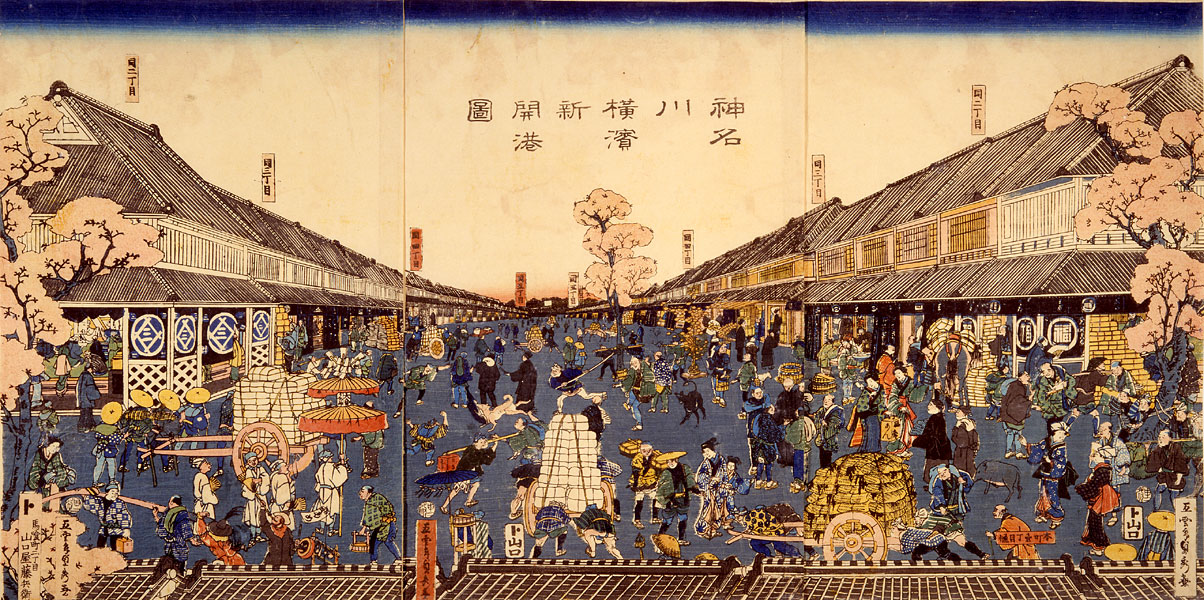
Kanagawa Yokohama shin kaiko zu Title: Picture of Newly Opened Port of Yokohama in Kanagawa Artist: Sadahide (1807-ca. 1878) 1860:2 Format: Woodblock print Medium: Ink and color on paper Dimensions: triptych: 36.6 x75 (14 3/8 x29 1/2 in.) Source: Arthur M. Sackler Gallery, Smithsonian Institution Using principles of perspective that had been introduced from European art into Japanese prints of the eighteenth-century, Sadahide depicted in this triptych the lively main street of Yokohama's Japanese business district. One of the earliest prints ofYokohama, this view of Honchō-dōri, the wide boulevard of the Japanese quarter, reveals no evidence of foreign settlers from the Five Nations, who in 1860 formed, in fact, only a very small community. Among the few distinctly foreign costumes are those worn by the candy vendors shown in the left foreground; their garments recall those displayed in Korean diplomatic processions. Filling the wide street are heavily laden peddler carts pushed by laborers, and packhorses, travelers, vendors, and a few women and children. The comfortable, practical, indigo-dyed clothing of the working men parallels the description of Japanese boatsmen and dockworkers written decades later by American painter John La Farge (1835-1910) upon his arrival at Yokohama in 1886. He observed "rowers standing in robes flapping about them, or tucked in above their waists. There were so many that the crowd looked blue and white - the colors of their dresses repeating the sky in prose." Dogs and even a tame boar run loose in the busy streets. The Japanese shops, unshuttered for the day, are full of a variety of merchandise, including the "curios" described in detail by Western travelers who seemed never to fail to spend some of their time shopping on Honchō-dōri. The Japanese commercial district as depicted by Sadahide resembles the scene encountered by British horticulturalist Robert Fortune in 1869: "The native town is remarkable for one fine wide street which runs down its centre. Here are exposed for sale the various productions of the country in very large quantities. Bronzes, carvings in ivory, lacquer-ware, and procelain, are all duly represented." The shop in the left foreground is marked with the distinctive trademark of Mitsui, Japan's wealthiest merchant house during the Edo period (1600-1868). Specializing in dry goods, and money lending and exchange, members of that family also served the Tokugawa shogunate as chartered merchants (goyō shōnin) who transmitted tax receipts from Osaka to Edo. Mitsui's establishment of a shop in Yokohama foreshadowed its future involvement with international trade, shipping, and finance. Having successfully adapted to rapidly changing political and economic conditions during the nineteenth and twentieth centuries, Mitsui is now one of Japan's second-largest general trading company (sōgō shōsha). [Adapted from Ann Yonemura, Yokohama: Prints from Nineteenth-Century Japan] Visualizing Cultures image number: Y0085 Keywords: Yokohama, Japanese district, Honchō-dōri, Mitsui, food, animals, trade goods, art influences from the West |
On viewing images of a potentially disturbing nature: click here. |
Massachusetts Institute of Technology © 2014 Visualizing Cultures |